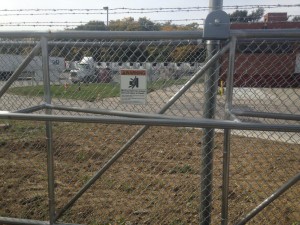Fencing at schools should both be safe and keep our children safe.
Last Thursday morning, I sat in traffic behind a sea of yellow caterpillars. All of them moving in different directions with heads bopping up and down inside. School is back in session…I was reminded. At the next stop light, I begin to drift away to an article I read about a teacher who severely damaged her hand in a gate at a local school. I thought that was odd because school fencing is there to keep our kids safe and therefore must be safe.
Fencing at schools must first be safe before keeping our kids safe. Fencing is designed to create a barrier between what we want to keep in and what we want to keep out. What better place to have a lot of fencing than at a school where we want to keep our kids in and keep strangers out. That makes sense barring the fencing does not poise unsafe hazards. Below are several things that you should look for at your children’s school regarding the fencing they play in and around all day long.
- Twisted sharp salvages. Fencing is available with the ends knuckled over on both the top and bottom. It is also available with one or both ends having twisted sharp barbs. Sometimes this type of end treatment, salvage, gets specified and installed because the designer borrowed the specification from a standard security fence design thinking he was simply keeping the kids secure and not knowing the typical hazards of a security fence.
- Icicles. Not the frozen kind but the ones you find on hot dipped galvanized chain link fabric when you run your hands across the face of the chain link. It will leave slight tears in the skin with some resulting in bleeding. School and recreational facilities should only use pregalvanized chain link fabric that is free from the icicles formed during the dipping of the fabric in the hot dipped process. This happens because most designers are not familiar with chain link fabric characteristics.

- Pinch points. Every gate operation presents some form of pinch point hazard. Thus, every gate should include signage that warns others that there is a potential hazard. This alerts school staff to be proactive in warning and educating children about the safe operation of gates and doors.
- Holes under the fence. We are not concerned about our children making a prison break. We simply do not want them to get their feet under the fabric during play. Kids are wearing open toed shoes and flip-flops to school. Regardless of the salvage type mentioned above, if a child gets his foot under the fabric and pulls it back, it will injure the child. We want to make sure that there are no holes under the chain link where a child may accidentally get caught.
- A safe distance. School staff should be educating our children to keep a safe distance from any fencing. Chain link fence has a lot of parts and pieces. Most of these have an edge or point that could injure a child. We should not see our children crawling on or over the fence.
With more of the yellow and black creatures stirring about, I am sadly reminded that summer is almost over. But hey, we got football coming!
